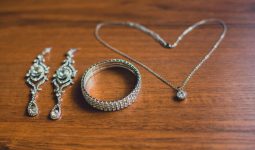There are many different types of silver. The number of different kinds of silver is determined by the type and the number of other metals used in the silver alloy.
Therefore, silver is mixed or alloyed with other hard metals. Furthermore, silver is used in many items around us, including popular jewelry and other antiques.
There are many different types of silver available in the market, and it is helpful to know the difference between some of them.
Knowing about some of these other alloys or hard metals is also helpful for understanding the value and desirability of jewelry and antiques.
Furthermore, silver, when not mixed with any other alloy in its purest form, is too soft for use in jewelry, and if used, it will easily get damaged or change shape.
The alloy added with other metals makes it harder and more durable.
All types of silver are the main constituents in jewelry, so knowing the difference between all these types of jewelry will help you see the value of what you want to purchase, making it hard for sellers to sell you what is not a high price.
It is important to know the different types of silver, especially if you love jewelry.
Know the difference between Argentium silver and Sterling alloy, the types of metals in a sterling alloy, and What Tibetan silver contains.
Here is an article discussing the different types of silver used in jewelry.
1. Fine. 999 Silver
Fine silver is one of the different types of silver, and it is the closest to pure silver elements.
Getting a stamp with .999 indicates that this type of silver is 99.9% pure, with only a relatively insignificant 0.1% additional element.
Furthermore, fine silver is not standard because of its characteristics of having only a 0.1% additional element.
They generally have a more vitreous luster than sterling silver, which is brightly polished. These types of silver also appear to be dull in color.
They are so soft and easily dented. Because of this type of silver softness, their shape can easily change. However, for this reason, it is less common in jewelry.
Furthermore, aside from all the disadvantages of being so soft, this type of silver is easily formed and fuses with solder.
They are also highly resistant to tarnish, Lustrous, and white. They are also hypoallergenic.
However, fine silver is best for pendants and earrings. Lastly, the stamp for fine silver is .999 or .999Fs.
2. Sterling .925 Silver
Sterling silver is one of the different types of silver. This type of silver is the most common silver alloy, which was common for centuries.
It’s the most standard of all the silver alloys in the world. Furthermore, this silver alloy is 92.5 percent silver and 7.5 percent copper.
Other metals like Nickel can be used. The alloy is added to the silver to increase the hardness of the material and make it more durable.
Furthermore, sterling silver is the standard quality jewelry in the United States. It is Lustrous, shiny, and very reflective.
However, sterling silver tarnishes quickly, changes color, and darkens easily. This type of silver has these cons because of its alloy’s 7.5 percent copper content.
But, they are generally easy to clean, and the tarnish can sometimes be cleaned.
The type of sterling is durable, wearable, and hypoallergenic. The mark for sterling silver is .925 or .925STG. However, some older marks are STG, STERLING, Or STER.
2. Argentium Silver
Argentium silver is a relatively new type of silver. These alloys are at least 92.5 percent silver, the rest copper, and the Germanium element is part of it.
Germanium element increases the strength of the alloy, making it harder and more resistant to tarnish.
Furthermore, this type of silver is a modern silver alloy. The silver alloy is essentially more durable and tarnish-resistant than sterling silver, and this type of silver is also a brand.
However, being a brand, only an authorized jeweler can use this type of silver, the Argentium stamp, which features a flying unicorn.
However, non-tarnish alloys can be tarnished under extreme conditions and generally less maintained than sterling silver. The price of Argentium silver is also higher than that of sterling silver.
Furthermore, Argentium silver is hard to differentiate from sterling silver because the mark of Argentium silver is .925, the same as the sterling silver mark.
However, Argentium silver is a brand type of silver, but some producers can request permission to use the Argentium Label.
3. Coin Silver
Coin silver was the standard and most common type of silver in the United States in the past.
This silver type is now rare, and sterling silver has become the standard.
Coin silver contains 90 percent pure silver, with the remaining alloy being copper. Furthermore, coin silver is technically .900 silver and 10% copper.
Coins silver is very similar to sterling silver, with the only difference being the amount of pure silver in the compound.
Furthermore, the name given to this type of silver is misleading because this alloy was not used to make coins in the past.
It got its name when some metalsmith made items from melted-down scrap coin metal.
This type of silver is with a stamp that usually comes with a certificate of authenticity.
4. Brittania Silver
This type of silver is stamped at .958, meaning 95.8 percent silver mixed with 4.2 percent copper. Brittania Silver is best for jewelry and silverware.
They generally have the same quality as sterling silver, but the only difference is that they contain a higher percentage of silver than sterling silver.
Furthermore, because of its high percentage of silver, they are softer than sterling silver.
5. Silver Filled
Silver filled is one of the different types of silver made from a new layered metal when silver prices surge during a recession.
This type of silver is not an alloy because the metal content is not the same quantity throughout the material.
Furthermore, silver-filled metals have characteristics similar to gold-filled metals.
But regarding value, it sits between sterling silver and silver plated.
Silver-filled metals generally contain at least 5 to 10 % silver bonded onto the base metal.
After the surge in the silver-filled market during the recession, the price of silver has now come down, making it incredibly hard to find these days.
However, silver-filled jewelry is difficult to maintain as it tarnishes quickly, and on the bright side, it is less expensive than sterling silver.
6. Silver Plated
Silver-plated is a type of silver with a very thin silver plate later on the surface. In this type of silver, the amount used in plating is tiny and almost negligible.
It is perfect for use in inexpensive costume jewelry, but it doesn’t last long.
Furthermore, the silver plate will wear over time, exposing the metal beneath the plated silver compound.
This type of silver is affordable and suitable for costume jewelry. The cons are that it is not durable, contains little silver, and is not hypoallergenic.
7. Nickel Silver
This is a type of silver that is best for costume jewelry. From the name, Nickel silver is primarily from Nickel or zinc.
These types of silver are generally cheap because their metal does not contain real silver.
Furthermore, this type of silver has many other names, like silver or silver in Alpaca. It is very soft and performs excellent metalwork.
Many people think nickel silver is a silver alloy, but it contains 60% copper, 20% zinc, and 20% nickel.
Nickel silver can be very bright and similar in appearance to sterling silver, and it can also be easily shaped and crafted into elaborate designs.
However, the cons are that they are not hypoallergenic, not silver, and are sometimes marketed as genuine sterling silver.
8. Tribal Silver
Tribal silver is one of the different types of silver that are base metal alloys that are only silver in appearance, and this type of silver contains no silver at all.
Furthermore, jewelry made with tribal silver should be bought with caution because some metals, such as lead, contain dangerous elements.
Furthermore, tribal silver is very beautiful and inexpensive. The cons are that it can contain dangerous metals, as earlier stated, and it may also not contain any silver, as stated above.
They have low durability and are not hypoallergenic.
9. Bali, Thai, or Mexican Silver
This type of silver comes from Bali, Thailand, and Mexico. Furthermore, this type of silver is with a quality stamp.
There are much lower silver alloy grades from these three countries: Thailand, Bali, and Mexico.
Knowing the types of silver in jewelry when buying jewelry can sometimes be very difficult.
This article was written to make you understand some of the differences in silver worldwide.
In conclusion, silver can be tested using X-ray testing in the laboratory, wet chemical analysis, or assay.
This wet chemical analysis or assay is the best way of testing the silver content of jewelry.








